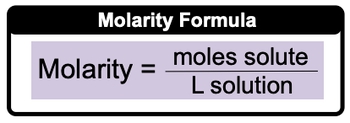Molarity, often denoted as M, is a key concept in chemistry that quantifies the concentration of a solute in a solution. It is defined as the number of moles of solute per liter of solution, providing a precise measurement of how much solute is present in a given volume of solvent. The formula for calculating molarity is expressed as:
M = \(\frac{\text{moles of solute}}{\text{liters of solution}}\)
In this context, the term "concentration" is sometimes used interchangeably with molarity, but it is important to note that concentration can refer to various ways of expressing the amount of solute in a solution, while molarity specifically focuses on the ratio of moles to volume. Understanding molarity is essential for solving problems related to solution preparation and chemical reactions, where precise measurements of reactants are crucial.
To calculate molarity, one must first determine the number of moles of the solute, which can be found using the formula:
moles = \(\frac{\text{mass (g)}}{\text{molar mass (g/mol)}}\)
Once the moles are calculated, dividing this value by the volume of the solution in liters will yield the molarity. This foundational knowledge of molarity and its calculation is vital for further studies in chemistry, particularly in areas involving solution chemistry and stoichiometry.



